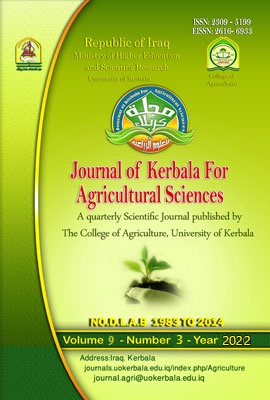Characterization and detection of some active compounds in seeds oil of Cumin (Cuminum cyminum) by GC-MS and GLC
DOI:
https://doi.org/10.59658/jkas.v9i3.997Keywords:
Cumin, ,GCMS, , GLC, Fatty acids, CuminaldehydeAbstract
The current study investigated some activities of chemical compounds which separated from Cuminum cyminum seeds and tested for their antibacterial activity against three types of bacteria that are pathogenic to humans and plants: Staphlococcus aureus, Escherichia.coli, Agrobicterum rhizogenes. The fatty acids were obtained after the soaponification process from the Petroleum ether extracted cumin seeds were separated by Soxhleet and diagnosed using (GC-MS) The volatile oils produced from cumin seeds were also separated using a Clevenger axis steam distillation device. Results, revealed that, cumin seeds are rich in with fatty acids, and this was indicated by the diagnostic results using GC-MS technology, as eight fatty acids were separated from the petroleum ether extract of cumin, including Octadecadienoic acid. Hexadecanoic acid, while the results of (GLC) showed the presence of the Cuminaldehyde in the separated oil, and that all of these compounds showed a high inhibitory effect against the bacteria used under study using the inhibitory activity test (susceptibility test) by drilling and estimating their inhibitory concentrations compared to the antibiotics used under study.
Downloads
Published
How to Cite
Issue
Section
License
Copyright (c) 2022 Copyright (c) 2024 is the Author's article. Published by the Journal of Kerbala for Agricultural Sciences under a CC BY 4.0 license

This work is licensed under a Creative Commons Attribution 4.0 International License.
Licensing Terms
All articles are published under a Creative Commons License and will be directed to the Creative Commons Attribution 4.0 International License (CC BY 4.0) That permits use, distribution, and reproduction in any medium, provided the original work is properly cited. This license also allows the work to be used for commercial purposes.
Use by both non-commercial and commercial users
This content is licensed under a Creative Commons Attribution 4.0 International (CC BY 4.0) license, permitting use by both non-commercial and commercial users. Individual users may access, download, copy, display, and redistribute the articles to colleagues, as well as adapt, translate, and text- and data-mine the content, subject to the following conditions:
- The author's moral rights, including the right of attribution and the right to protect their work from derogatory treatment, are respected.
- Where content in the article is identified as belonging to a third party, users must ensure that any reuse complies with the copyright policies of the owner of that content.
- If the article content is reused for research or educational purposes, users should maintain a link to the appropriate bibliographic citation, including the DOI and a link to the published version on the journal's website.






